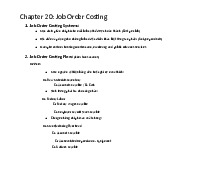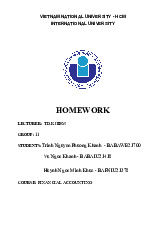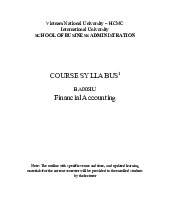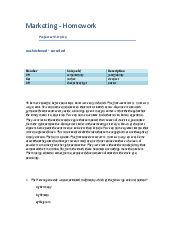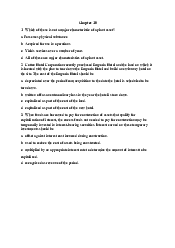





































Preview text:
CHAPTER 6
INTERNATIONAL PARITY CONDITIONS LE L AR A N R I N N I G G O B O J B E J CTI T V I E V S
•Examine how price levels and price level changes (inflation)
in countries determine the exchange rates at which their currencies are traded
•Show how interest rates reflect inflationary forces within each country and currency
•Explain how forward markets for currencies reflect
expectations held by market participants about the future spot exchange rate
•Analyze how, in equilibrium, the spot and forward currency
markets are aligned with interest differentials and
differentials in expected inflation
INTERNATIONAL FINANCE - CHAPTER 6 – INTERNATIONAL PARITY CONDITIONS
International Parity Conditions Some fundamental questions managers of MNEs,
international portfolio investors, importers, exporters, and
government officials must deal with every day are:
◦ What are the determinants of exchange rates?
◦ Are changes in exchange rates predictable?
The economic theories that link exchange rates, price levels,
and interest rates together are called international parity conditions.
These international parity conditions form the core of the
financial theory that is unique to international finance.
INTERNATIONAL FINANCE - CHAPTER 6 – INTERNATIONAL PARITY CONDITIONS Prices and Exchange Rates
If the identical product or service can be:
Øsold in two different markets; and
Øno restrictions exist on the sale; and
Øtransportation costs of moving the product between markets are equal, then
Øthe product’s price should be the same in both markets.
This is called the law of one price.
INTERNATIONAL FINANCE - CHAPTER 6 – INTERNATIONAL PARITY CONDITIONS Prices and Exchange Rates
A primary principle of competitive markets is that prices will
equalize across markets if frictions (transportation costs) do not exist.
Comparing prices then, would require only a conversion from one currency to the other: P$ x S¥/$ = P¥.
The product price in U.S. dollars is (P$), the spot exchange rate is
number of yen per dollar (S¥/$), and the price in yen is (P¥). The implied interest rate: P¥. P$
INTERNATIONAL FINANCE - CHAPTER 6 – INTERNATIONAL PARITY CONDITIONS Prices and Exchange Rates
If the law of one price were true for all goods and services,
the purchasing power parity (PPP) exchange rate could be
found from any individual set of prices.
By comparing the prices of identical products denominated
in different currencies, we could determine the “real” or PPP
exchange rate that should exist if markets were efficient.
This is the absolute version of the PPP theory.
INTERNATIONAL FINANCE - CHAPTER 6 – INTERNATIONAL PARITY CONDITIONS
Selected Rates from the Big Mac Index
INTERNATIONAL FINANCE - CHAPTER 6 – INTERNATIONAL PARITY CONDITIONS
Selected Rates from the Big Mac Index
INTERNATIONAL FINANCE - CHAPTER 6 – INTERNATIONAL PARITY CONDITIONS Prices and Exchange Rates
qIf the assumptions of the absolute version of the PPP theory
are relaxed a bit more, we observe what is termed relative
purchasing power parity (RPPP).
qRPPP holds that PPP is not particularly helpful in determining
what the spot rate is today, but that the relative change in
prices between two countries over a period of time
determines the change in the exchange rate over that period.
INTERNATIONAL FINANCE - CHAPTER 6 – INTERNATIONAL PARITY CONDITIONS Prices and Exchange Rates
More specifically, with regard to RPPP:
“If the spot exchange rate between two countries
starts in equilibrium, any change in the differential
rate of inflation between them tends to be offset over
the long run by an equal but opposite change in the spot exchange rate.”
INTERNATIONAL FINANCE - CHAPTER 6 – INTERNATIONAL PARITY CONDITIONS
Relative Purchasing Power Parity (PPP)
INTERNATIONAL FINANCE - CHAPTER 6 – INTERNATIONAL PARITY CONDITIONS Prices and Exchange Rates
Empirical testing of PPP and the law of one price has been
done, but has not proved PPP to be accurate in predicting future exchange rates.
Two general conclusions from these tests:
◦ PPP holds up well over the very long run but poorly for shorter time periods
◦ the theory holds better for countries with relatively high rates of
inflation and underdeveloped capital markets.
INTERNATIONAL FINANCE - CHAPTER 6 – INTERNATIONAL PARITY CONDITIONS Prices and Exchange Rates
Individual national currencies often need to be evaluated against other currency values to determine relative purchasing power.
The objective is to discover whether a nation’s exchange rate
is “overvalued” or “undervalued” in terms of PPP.
This problem is often dealt with through the calculation of
exchange rate indices such as the nominal effective exchange rate index.
INTERNATIONAL FINANCE - CHAPTER 6 – INTERNATIONAL PARITY CONDITIONS
IMF’s Real Effective Exchange Rate Indexes for the United
States, Japan, and the Euro Area
INTERNATIONAL FINANCE - CHAPTER 6 – INTERNATIONAL PARITY CONDITIONS Exchange Rate Pass-Through
Incomplete exchange rate pass-through is one reason that a
country’s real effective exchange rate index can deviate.
The degree to which the prices of imported and exported
goods change as a result of exchange rate changes is termed pass-through.
For example, a car manufacturer may or may not adjust
pricing of its cars sold in a foreign country if exchange rates
alter the manufacturer’s cost structure in comparison to the foreign market.
INTERNATIONAL FINANCE - CHAPTER 6 – INTERNATIONAL PARITY CONDITIONS Exchange Rate Pass-Through
INTERNATIONAL FINANCE - CHAPTER 6 – INTERNATIONAL PARITY CONDITIONS Prices and Exchange Rates
Pass-through can also be partial as there are many
mechanisms by which companies can compartmentalize or
absorb the impact of exchange rate changes.
Price elasticity of demand is an important factor when
determining pass-through levels.
The own-price elasticity of demand for any good is the
percentage change in quantity of the good demanded as a
result of the percentage change in the good’s own price.
INTERNATIONAL FINANCE - CHAPTER 6 – INTERNATIONAL PARITY CONDITIONS Interest Rates and Exchange Rates
The Fisher effect states that nominal interest rates in each country are
equal to the required real rate of return plus compensation for expected inflation.
This equation reduces to (in approximate form): i = r +
where i = nominal interest rate, r = real interest rate and = expected inflation.
Empirical tests (using ex-post) national inflation rates have shown the
Fisher effect usually exists for short-maturity government securities (treasury bills and notes).
INTERNATIONAL FINANCE - CHAPTER 6 – INTERNATIONAL PARITY CONDITIONS
Interest Rates and Exchange Rates
qThe relationship between the percentage change in the spot exchange
rate over time and the differential between comparable interest rates in
different national capital markets is known as the international Fisher effect.
q“Fisher-open” - the spot exchange rate should change in an equal
amount but in the opposite direction to the difference in interest rates between two countries.
INTERNATIONAL FINANCE - CHAPTER 6 – INTERNATIONAL PARITY CONDITIONS Interest Rates and Exchange Rates More formally:
where i$ and i¥ are the respective national interest rates
and S is the spot exchange rate using indirect quotes (¥/$).
Justification for the international Fisher effect is that
investors must be rewarded or penalized to offset the
expected change in exchange rates.
INTERNATIONAL FINANCE - CHAPTER 6 – INTERNATIONAL PARITY CONDITIONS Interest Rates and Exchange Rates Example:
1. Suppose the interest rate on a one-year insured U.S. bank
deposit is 9% and the rate on a one-year insured British
bank deposit is 10%. What does the International Fisher
Effect predict will happen to the exchange rate?
2. Suppose the interest rate in the U.S. is 1.5% and the
interest rate in France is 2.25%, where USD is foreign
currency. Suppose that the spot exchange rate between
USD and EUR is EUR/USD 0.7088. What is the future spot
exchange rate assuming that the International Fisher Effect holds?
INTERNATIONAL FINANCE - CHAPTER 6 – INTERNATIONAL PARITY CONDITIONS
Interest Rates and Exchange Rates
qA forward rate is an exchange rate quoted for settlement at some future date.
qA forward exchange agreement between currencies states
the rate of exchange at which a foreign currency will be
bought forward or sold forward at a specific date in the future.
qThe forward rate is calculated for any specific maturity by
adjusting the current spot exchange rate by the ratio of
eurocurrency interest rates of the same maturity for the two subject currencies.
INTERNATIONAL FINANCE - CHAPTER 6 – INTERNATIONAL PARITY CONDITIONS Interest Rates and Exchange Rates
qFor example, the 90-day forward rate for the Swiss
franc/U.S. dollar exchange rate (FSF/$90) is found by
multiplying the current spot rate (SSF/$) by the ratio of the
90-day euro-Swiss franc deposit rate (iSF) over the 9 - 0 day eurodollar deposit rate (i$).
INTERNATIONAL FINANCE - CHAPTER 6 – INTERNATIONAL PARITY CONDITIONS Interest Rates and Exchange Rates
Forward premium or discount of the numerator currency: percentage difference
between the spot and forward exchange rates, in annual percentage terms FSF = Spot – Forward 360 x x 100 Forward days
This is the case when the foreign currency price of the home currency is used (SF/$).
INTERNATIONAL FINANCE - CHAPTER 6 – INTERNATIONAL PARITY CONDITIONS
Exhibit 6.5 Currency Yield Curves and the Forward Premium
Interest Rates and Exchange Rates
Theory of Interest Rate Parity (IRP) provides the linkage between the foreign exchange markets and the international money markets.
The difference in the national interest rates for securities
of similar risk and maturity should be equal to, but
opposite in sign to, the forward rate discount or premium
for the foreign currency, except for transaction costs.
INTERNATIONAL FINANCE - CHAPTER 6 – INTERNATIONAL PARITY CONDITIONS Interest Rate Parity (IRP)
Interest Rates and Exchange Rates
The spot and forward exchange rates are not, however,
constantly in the state of equilibrium described by interest rate parity.
When the market is not in equilibrium, the potential for “risk-
less” or arbitrage profit exists.
The arbitrager will exploit the imbalance by investing in
whichever currency offers the higher return on a covered basis.
This is known as covered interest arbitrage (CI ) A .
INTERNATIONAL FINANCE - CHAPTER 6 – INTERNATIONAL PARITY CONDITIONS Covered Interest Arbitrage (CIA) If the difference in
interest rates is greater than the forward Covered
premium (or expected change in the spot interest
rate), invest in the higher interest yielding
currency. If the difference in interest rates is arbitrage
less than the forward premium (or expected (CIA)
change in the spot rate), invest in the lower
interest yielding currency.
INTERNATIONAL FINANCE - CHAPTER 6 – INTERNATIONAL PARITY CONDITIONS
Interest Rates and Exchange Rates
A deviation from covered interest arbitrage is uncovered interest arbitrage (UI ) A .
In this case, investors borrow in countries and currencies
exhibiting relatively low interest rates and convert the proceed
into currencies that offer much higher interest rates.
The transaction is “uncovered” because the investor does not
sell the higher yielding currency proceeds forward, choosing to
remain uncovered and accept the currency risk of exchanging
the higher yield currency into the lower yielding currency at the end of the period.
INTERNATIONAL FINANCE - CHAPTER 6 – INTERNATIONAL PARITY CONDITIONS Uncovered Interest Arbitrage (UIA): The Yen Carry Trade
Interest Rates and Exchange Rates
Some forecasters believe that forward exchange rates are
unbiased predictors of future spot exchange rates.
Thus, the distribution of possible actual spot rates in the
future is centered on the forward rate.
Unbiased prediction: the forward rate will, on average,
overestimate and underestimate the actual future spot rate in equal frequency and degree.
INTERNATIONAL FINANCE - CHAPTER 6 – INTERNATIONAL PARITY CONDITIONS
Forward Rate as an Unbiased Predictor for Future Spot Rate International Parity Conditions in Equilibrium (Approximate Form) In I ter e na n ti t o i n o a n l lP ar a i r t i y t y C on o d n it i i t o i n o s n s in i n E quiliilb i r b iu i m u A. Purchasing Power Partity B. The Fisher effect C. International Fisher effect
INTERNATIONAL FINANCE - CHAPTER 6 – INTERNATIONAL PARITY CONDITIONS In I ter e na n ti t o i n o a n l lP ar a i r t i y t y C on o d n it i i t o i n o s n s in i n E quiliilb i r b iu i m u D. Interest Rate Parity
E. Forward rate as an unbiased predictor
INTERNATIONAL FINANCE - CHAPTER 6 – INTERNATIONAL PARITY CONDITIONS
